Afghan Hound
BREED INFO
- Group – Hound
- Height – 27 to 29 inches at the shoulder
- Weight – 25-29 KG
- Life Span – 12-14 years
The Afghan hound was discovered by the Western World in Afghanistan and surrounding regions during the 19th century. As the breed developed in Afghanistan, two distinct types evolved from the southern and western desert regions and the northern regions. During WWI, the breed literally disappeared in the Western world. The start of the Afghan Hounds we have today dates back to 1920, when a group of them was brought to Scotland.The Afghan Hound is a hound that is one of the oldest dog breeds in existence. Distinguished by its thick, fine, silky coat and its tail with a ring curl at the end, the breed acquired its unique features in the cold mountains of Afghanistan. The Afghan Hound breed is no longer used for hunting, although it can be seen in the sport of lure coursing Spectacular beauty of Afghan Hound dogs caused them to become highly desirable show dogs and pets.
History

The Afghan Hound was not discovered by the western world until the early 1800’s. The breed’s history before that time is somewhat unclear, although it is thought that the Afghan Hound is a descendant of the Saluki, from what at that time was Persia. It is known that Afghans were originally developed for chasing prey in the mountainous regions of its native Afghanistan (and neighboring India and Pakistan). Secondarily, Afghans did double duty as guardians for nomadic tribes and their livestock. However, they were primarily used as coursing hounds, to sight and follow mountain deer, plains antelope, foxes and hares, or whatever other animal prospered in a particular locality. Human hunters who followed behind on horseback would make the kill. Afghan Hounds were also used to bring to bay predators such as wolves, jackals, wild dogs and even snow leopards, and to flush fowl such as quail and partridge. They were prized not only for their great speed, but also for their unparalleled ability to traverse irregular and potentially hazardous terrain with stability and sure-footedness. Afghans developed extreme agility, quickness and stamina, and retain those traits today.
No one knows how old this breed truly is, but today’s Afghan Hounds are descended from a group brought to Scotland from Baluchistan, which today is a part of Pakistan, in the 1920’s. Thereafter, a number of these dogs were exported to the United States. The American Kennel Club opened its Hound Group registry to them in 1926, with the first American-bred Afghan Hound being registered in 1927. The parent club for this breed was not founded until 1937, reorganized in 1938, and then was admitted to AKC membership in 1940 as the Afghan Hound Club of America.
Personality and Temperament
Afghan Hounds are calm indoors, yet active outside. They’re intelligent, proud, and noble. This breed has a high prey drive and may not get along with small animals.

This breed is often very dominant toward other males. They are tolerant of children who treat them with respect. The temperament of the typical Afghan Hound can be aloof and dignified, but happy and clownish when it’s playing.
Hair, Care and Grooming
The coat may be any color, but white markings, particularly on the head, are discouraged. Hair is thick, silky, very fine and long. The long topknot and the shorter-haired saddle on the back of the dog are distinctive features of the Afghan Hound coat
The Afghan Hound must be groomed very carefully for a full hour, twice weekly. Ears must be kept clean.
Health
This breed seems to have a low pain tolerance, so they may suffer with minor injuries.
Training and Activity
This breed is fairly difficult to train, due to its independent nature. They are independent thinkers who don’t particularly care about pleasing you. They may display passive resistance by bracing their legs and refusing to move. You must show them, through absolute you mean what you say.

The Afghan Hound needs lots of exercise and space to allow it to burn off steam.
Feeding
The food you give to your Afghan Hound will not be untypical for that of most dog breeds, but many people try different foods in order to “treat” the Afghan Hound’s coat – people who show their Afghan Hound, in particular. You don’t have to take any special precautions in your dog’s diet beyond assuring essential nutrition and a general food level that keeps the dog at a healthy weight.







